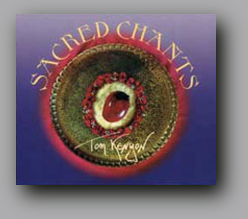Sacred Chants

1 Natya (Upik)
“Natya” Translation: “Oh Grandfather, Oh Grandmother, please bless us now.” In many indigenous cultures, such as the Upiks of eastern Alaska, the spiritual dimension is viewed as masculine (Father) and the earth dimension as feminine (Mother). This chant asks for a blessing from both realms of being. The first part of the chant is traditional, in which the word “natya” is sung. The second part, without words, is not. I see it as a shamanic passage in the chant, allowing the chanter to express the feelings of blessing being received from spirit and matter.
2 Song to the Sun and Moon (Hindu)
“Om Sureya, Om Chandra, Shanti, Shanti, Shanti” Translation: “Praise to the sun, Praise to the moon, peace, peace, peace.” Traditionally, this chant is offered only to the sun (sureya). But by adding the moon (chandra) we are in keeping with a deep alchemical truth of consciousness. By balancing our internal solar (male) and lunar (female) aspects of mind, we can attain greater spiritual illumination. The repetition of the word shanti (peace) refers to a silencing or balancing of the three sub-atomic forces of the universe known as the three gunas. By balancing the “play” of the gunas within ourselves, we attain illumination.
3 Allah (Islam)
“Allah, Allah, La il laha, il ‘l laha” Translation: “Allah, Allah, There is only God.” This chant is from the Sufis, the mystical sect of Islam. Traditionally this chant is spoken rather than sung. The essential meaning of the chant is that there is one fundamental power in the universe and that all things stem from this power (Allah).
4 Gayatri Mantra (Hindu)
“Om Bhoor, Bwaha, Swaha, Tat Saveteur Vareneeum, Bhargo, Dawasai, Demahai, Dehyo Yo Nah Pracho Dhai Yat.” Translation: “Praise to the source of all things. It is due to thee that we attain true happiness on the earth, astral and causal planes. It is due to thy ever transcendent nature that you are worthy of being worshipped and adored. Ignite us with thy all pervading light.” It is said by the yogis/yoginis and saints of India that this chant brings great protection and illumination to he or she who recites it. This chant is one of the oldest known to exist in the world. When chanting or listening to this chant, it is traditional to place one’s awareness or mental focus in the ajna center, located mid-way between the eyes, about an inch (two centimeters) back, behind the bridge of the nose.
5 Akul (Egyptian)
“Akul.” Translation: “The ancient ones.” This chant from ancient Egypt calls forth the ancient ones who have attained the “light body,” a highly energized “subtle body” created through the action of spiritual alchemy. Mid-way through the chant, the names of various Egyptian deities are repeated. The term “Nuk Pu Neter…” means “I am the power of ….” and is followed by the name of a deity. This is one of the most ancient ways of expanding consciousness. By identifying with a being or an attribute, we take on those qualities. By identifying ourselves with the Akul, we can take on some of the qualities and insights of these high masters.
6 Peme’s Song/Chant of Padmasambhava (Tibetan Buddhist)
PART ONE: “Om Peme Vajra Guru Siddhi Hum” Translation: “Praise to Peme the Vajra Guru (he who cuts through illusion) and for the blessings of spiritual power he bestows.”
PART TWO: “Om Ah Hum Vajra Guru Padma Siddhi Hum” Translation: “Praise to the three jewels and Padmasambhava, the vajra guru who bestows spiritual blessings.” Padmasambhava was a fully realized tantric master credited with bringing Buddhism to Tibet. Tibetans refer to him endearingly as Peme, and the first part of this chant is a song of appreciation for this great being. As a Bodhisattva, Padma remains in the illusion of samsara for the benefit of all sentient beings. No longer in physical embodiment, he exists in his subtle energy body in the realm of pure sound and light (Samboghaya). The second part of the chant is the traditional mantra for this being. It is said that the mantra has the power to connect one directly to the blessings of this siddhi guru.
7 Chant to Shiva, Parvati and Ganesha (Hindu)
“Om Shri Shiva, Om Maha Parvati, Om Shri Ganesha, Om Namaha Shivaya.” Translation: “Praise to Lord Shiva, Praise to the Great Parvati, Praise to Lord Ganesha, Praise to the name of Shiva.” Shiva as the male aspect of creation (spirit) is considered to be the Lord and Protector of yogis (male) and yoginis (female). His consort is Parvati, the female aspect of cre- ation or matter. Their child is Ganesha, part human, part elephant. As the union of spirit and matter, he is known as Lord Ganesha, the Destroyer of Obstacles. This chant is a celebration of the three aspects of consciousness—spirit, matter and spirit-in-matter.
8 Tara Lands (Tibetan Buddhist)
“Om Tare Tutare Ture SoHa.” Translation: “Praise to Tara the Swift Protectoress.” Tara is one of the Tibetan Buddhist benefactor deities. She was actually embodied and legend says that upon reaching full illumination, she was approached by lamas. They told her that since she had attained enlightenment she could now reincarnate as a man. She reportedly told them that she would always remain in the form of a woman. Rather than enter the Dharmakaya (the Bliss of Nirvana) she remains in the Samboghaya (the realm of pure sound and light). She is considered to be a Bodhisattva—one who remains in samsara (the world of illusion) for the benefit of other sentient beings. It is said that those who chant her mantra are blessed with her protection. Existing, as she does, in the realm of pure sound and light (Samboghaya) she has 21 aspects, each one a different color. To call upon Tara is to call upon a powerful beneficent being.
9 Shenasha (Navajo/Dineh)
“She na sha, She na sha, She na sha, Bekay Hozhona Eya Hey Neya, Bekay Hozhona Eya Hey Neya, Bekay Hozhona Eya Hey Neya, Ahala, Ahala, Gonah Sha, Ahala, Ahala, Gonah Sha” Translation: “We walk with beauty before, behind and all around us. We are happy. We are free.” The Navajo (Dineh) have a word for healing that translates as “a return to beauty.” This chant is a call to return to that inherent beauty of creation. I ended the recording with this particular chant because I agree with the sentiment. May we all find the beauty inside and outside of us. And may beauty follow us all the days of our lives.
Return to main Sacred Chants page



